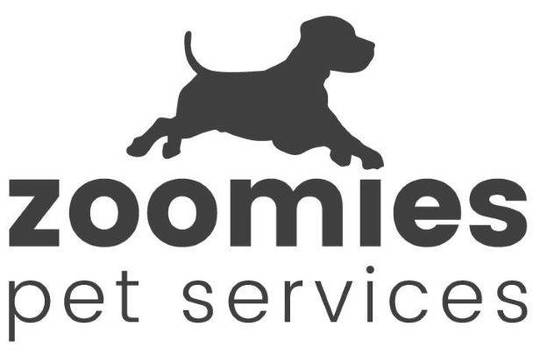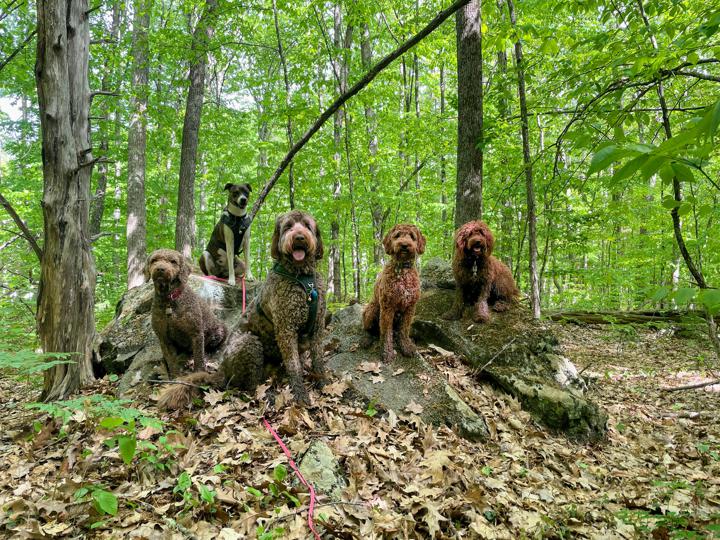
Over the past couple of years, we’ve seen many of our friends, family, and colleagues become pet parents as they welcome a new pet into their family. Did you know that nearly 1 in 5 households got a pet during the COVID-19 pandemic? With some pet parents going back into the office, we’ve seen a change in the way people care for their pets. According to a recent report by Forbes, 66% of pet parents say they’ve spent more money on their pets in the last six months than they usually would in order to help their pets adjust to being alone more. With the increase in pets, the demand for pet care professionals has increased too!
We at PetPocketbook have seen many of the businesses on our platform grow, hire new employees, onboard more clients, and start to expand their service offerings. Businesses that once started off as part-time side gigs have now turned into full-fledged businesses with hundreds of clients and many employees. Not only has the demand for business changed, but the types of services available to pet parents have changed too. We’re seeing more businesses start to offer off-leash dog walking, sometimes referred to as dog hiking, doggy day school, off-leash adventures, or dog camp.
Dog camp is another way to provide an opportunity for dogs to spend time off-leash and under the control of a professional dog walker, many of whom are also certified dog trainers. During camp, dogs work on a variety of skills including recall, relaxation, impulse control, healthy socialization, and opportunities to play. It’s especially good for high-energy breeds who need a little more than a couple of walks around the block everyday.
If you’re thinking about growing your pet care business by expanding your service offering to include these types of services, you’re in luck! We caught up with Sarah Rohrdanz, owner of Zoomies Pet Services in New Hampshire to learn more about her off-leash dog camp. Sarah started in the pet care industry back in 2016, and by 2018, she started her own business. She’s certified in dog training and behavior from CATCH Canine Trainer’s Academy, is pet first aid and CPR certified, and has completed a six-week online professional dog hiking course, My Dog Camp. Zoomies works with all types of dogs, from the reactive or fearful to outgoing and social butterflies, she and her staff are trained to keep your dog safe, engaged, and well cared for.
The power of networking
“When I first started out, there weren’t a lot of other pet care professionals in my area, so I was kind of on my own. To advertise, I put up fliers everywhere and posted in community Facebook groups. I got quite a few clients from local Facebook groups, so if you’re not in them, join a couple and introduce yourself! Now that my business is a little more established, I want to be able to help others start and grow their business. To help, I started a group for local pet care professionals to get to know others in my area. It’s a place where you can ask questions, refer clients to one another, and continue learning more about the industry.”
While out on the trails, Sarah met Brie, another dog walker in her area who offers off-leash dog camp. Sarah found herself walking her dogs along with Brie’s pack and admired how much control she had over the dogs. “Dog camp was something I was interested in starting to offer to my clients. Brie had taken an online course that teaches you how to start your own dog camp business and highly recommended the course to me.” The course, My Dog Camp, is led by professional dog trainer, Rhonda Bilodeau of Vermont Dog Pack, who has operated her dog camp and private dog training business for over 14 years.
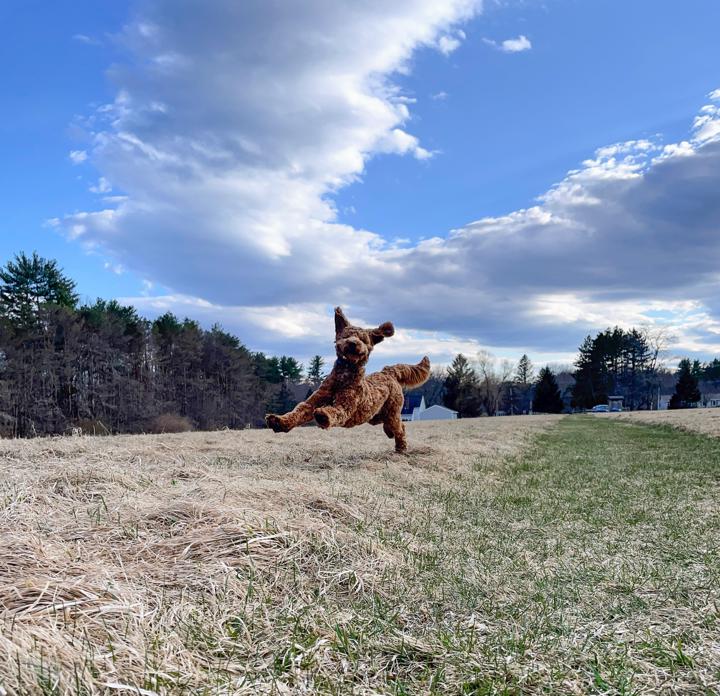
Getting started with camp
In March of 2021, Sarah began leading her own dog camp. Since then, she’s learned a lot about how to safely take her pack out on the trails for a day of fun. “I love the off-leash group walks. I’ve hired more staff members to help with on-leash walks so that I’m able to spend more time running camp. It’s so much fun and so important to educate yourself. You’re responsible for the dogs and need to be prepared for all different types of situations – and understand that camp isn’t for every dog. You must pick the right dogs, have the right equipment, and be able to rely on the dog’s training. If you’re not responsible, it ruins it for everyone else.”
The biggest piece of advice Sarah has for anyone offering dog camp is to pick the right dogs for camp. “If a new client reaches out to us who is interested in joining camp, we need to evaluate them first to see if it’s the right fit. I’ll invite clients to join PetPocketbook where they can fill out their profile and get some background information about the dog, so I’m prepared during the evaluation. At the evaluation, we’ll put their skills to the test to see if they’re ready for camp or not.”
Requirements for camp are that dogs are over a year old, have no history of aggression, are good with other dogs and people, are calm in the car and on walks, and are recall trained. “I won’t approve a dog for camp until I walk them at least once by themselves and test the dog’s recall. It’s the one thing I take with a grain of salt when clients tell me their dog has good recall. It’s so important to have since camp is off-leash, so I always test them first. I also like to take them out with another dog to see how they behave around others. If the dog is a fit, clients can start requesting dog camp right in PetPocketbook.”
If dogs aren’t quite ready to join the pack or aren’t a fit for a group activity, Zoomies offers private training hikes. It’s a great option for dogs who aren’t great with other dogs, or for dogs who need to work on different skills before joining camp. If dogs are too young, they offer puppy adventure outings to help prepare them for camp in the future. If a dog isn’t quite ready for camp, Sarah recommends that her clients work with their pets on a few things at home. “Training seems surprisingly easy but is hard in practice. Be really consistent! You must reward good behavior every time to help them learn what they need to do themselves without you having to tell them.” Three things Sarah recommends that her clients work on are recall, remaining calm (especially with distractions!), and basic obedience that helps with impulse control. For example, opening the car door without jumping out, sitting and staying, and not pulling on the leash.
Safety is always the top priority
From the moment dogs are picked up and in the care of Sarah and her team, safety is always the priority. “We start in the car and wait until everyone is calm before we head out onto the trails. Sometimes transportation can be tricky – some dogs don’t like being touched in the car or they may try to bother one another. I separate the dogs if they don’t know each other. It helps with over-excitement because the dogs can sniff each other but not get at each other. We have to be patient! Sometimes it can take 30 minutes or so for everyone to be calm and comfortable before we’re ready to get out on the trails.”
“Once we’re out of the car, we’ll do a sit stay until I see that everyone is relaxed. Once everyone is calm and in the right mindset, I’ll release them. This process repeats throughout our time together to make sure everyone is calm and in control. We pay attention to what they’re doing and how the dogs are responding to each other. Are they respecting each other? Watch out for vocalization too – make sure both dogs want to play and are respectful if the other has had enough. When a dog is overwhelmed or overstimulated, we’ll do a lot of pack walking to help us regroup. Pack walking is when I ask the dogs to walk behind me – it helps calm them down for a minute. We do a lot of sit stays too! And with any good behavior, we’ll reward it with treats – like when they are calm or displaying any behavior we want to see.”
To keep everyone safe during camp, Sarah has a couple of tools that prepare her for various situations. “Long lines have been a huge game changer! The length of the line depends on how much I trust the dog and their recall. I use biothane lines I bought from CSJ Creations on Etsy that are waterproof and stink-proof. I always carry a muzzle for camp too – you never know what’s going to happen. For example, if a dog hurts themselves, they could lash out because of the pain. And no matter what, you should always carry all the leashes for the dogs just in case.” Sarah also recommends carrying a spray bottle of vinegar and water for any unwanted off-leash dogs that may approach and attaching bells to the dogs to help scare off any wildlife and warn others that they’re approaching. Depending on the season and where you live, she also recommends carrying a natural tick spray and putting bandanas on the dogs during hunting season.
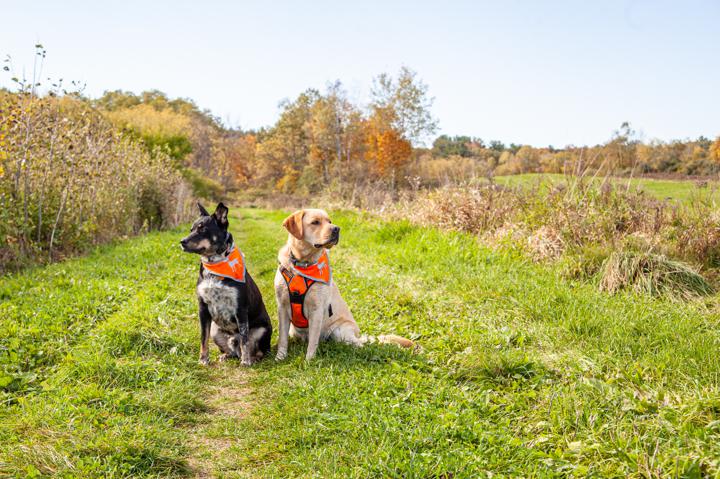
One of the most important tools to use during camp is treats. Sarah uses lots of treats throughout dog camp to mark any good behavior and provide dogs with a positive experience. “I use a mix of high value treats out in the woods and on the trails where distractions will arise. My favorites are freeze dried liver, food toppers, and chewy training treats. I try to buy what’s on sale and get a lot from Chewy, but check out your local pet stores too!”
Tips and advice
Like many businesses, you may be feeling the pressure at the pump as gas prices continue to rise or remain high. To help, Sarah recommends keeping your service area small because it’s more efficient. Scheduling your pickup order by location can save you time and fuel, which is especially important these days! “Right now, we’re scheduling camp based on where the dogs live, who is offering camp that day, and where we’re heading out that day. The scheduling features in PetPocketbook are great for groups. When you need to make a change it’s easy. You can drag and drop the entire pack to move everyone to a new time slot, and I can click on a dog and drag and drop them in the order of my route so that I can plan out my pickup order.”
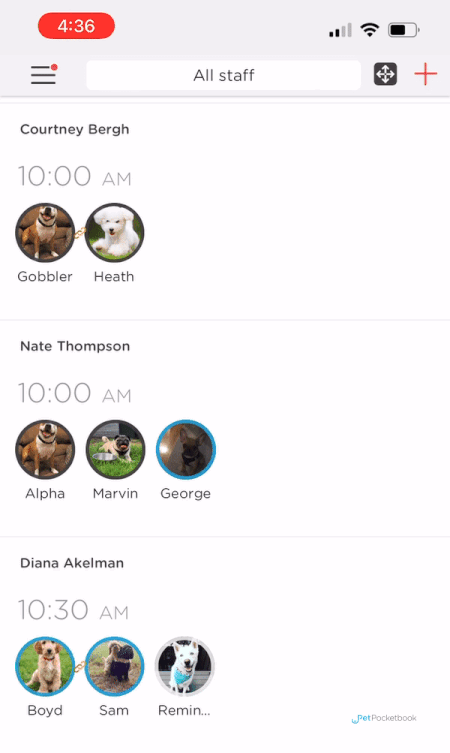
“Allowing pet parents to request appointments online is helpful and eliminates some of the back-and-forth communications with clients. Being able to set and show clients an arrival window is helpful too, especially with camp. It provides more flexibility and helps set the expectation that we will get there sometime during the time block and not at a specific time.” To help you stay organized and safe, you can also set a limit in PetPocketbook on how many pets each handler can safely accommodate for camp. For example, let’s say you offer a morning pack and an afternoon pack for dog camp and set a limit of 10 dogs for this service; clients will no longer be able to request morning dog camp through their pet parent portal once you have 10 dogs confirmed for all staff members at that time.
“If you’re just starting out, it can be tough! I like to help others because there weren’t others at the time when I got started. The most important thing is that you have the confidence to get out there and do it.”
If you’re interested in starting your own dog camp, you can use Sarah’s code “ZOOMIES100” for $100 off My Dog Camp courses. Want to learn more about how PetPocketbook can help support your pack walking or dog camp business? Let’s get in touch! Book a demo and get started with a free 60-day trial!
